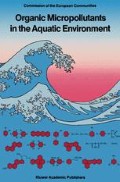Summary
An account is given of microbiological procedures for investigating the fate of xenobiotics discharged into the aguatic environment. A brief account is given of the experimental procedures which have been developed, and their application is exemplified from the results of experiments with chloroguaiacols and related compounds. Experiments encompass both aerobic and anaerobic transformations, and emphasis is placed on environmental factors of cardinal significance in determining the outcome of laboratory experiments. An attempt is made to assess the environmental relevance of the data acguired by carrying out experiments in which natural sediment samples were spiked with the xenobiotics. Attention is directed to the significant role of binding to sediments.
Access this chapter
Tax calculation will be finalised at checkout
Purchases are for personal use only
Preview
Unable to display preview. Download preview PDF.
References
Alexander, M. 1975. Environmental and microbiological problems arising from recalcitrant molecules. Microbiol.Ecol. 2: 17–27 .
Allard, A.-S., M. Remberger, and A.H. Neilson. 1985. Bacterial O-methylation off chloroguaiacols : effect of substrate concentration, cell density, and growth conditions. Appl. Environ. Microbiol. 49 : 279–288.
Allard, A.-S., M. Remberger, and A.H. Neilson. 1987. Bacterial O-methylation of halogen-. substituted phenols. Appl. Environ. Microbiol. 53 : 839–845.
Atlas, E., K. Sullivan, and C.S. Giam. 1986. Widespread occurrence of polyhalogenated aromatic ethers in the marine environment. Atmos. Environ. 20 : 1217–1220.
Heitkamp, M.A., J.A. Freeman, and C.E. Cerniglia. 1987. Naphthalene biodegradation in environmental microcosms : estimates of degradation rates and characterization of metabolites. Appl. Environ. Microbiol. 53: 129–136.
Häggblom, J. Apajalahti, and M. Salkinoja-Salonen. 1986. Metabolism of chloroguaiacols by Rhodococcus chlorophenolicus. Appl. -Microbiol. Biotechnol. 24: 397–404.
Neilson, A.H., A.-S. Allard, S. Reiland, M. Remberger, A. Tärnholm,T. Viktor, and L. Landner. 1984. Tri-and tetra-chloroveratrole, metabolites produced by bacterial O-methylation of tri-and tetrachloroguaiacol : an assessment of their bioconcentration potential and their effects on fish reproduction. Can. J. Fish. Aquat. Sci. 41 : 1502–1512.
Neilson, A.H., A.-S. Allard, and M. Remberger. 1985. Biodegradation and transformation of recalcitrant compounds, p. 29–86. In. O. Hutzinger (ed.) Handbook of Environmental Chemistry. Vol. 2/C. Springer-Verlag, Berlin.
Neilson, A.H., A.-S. Allard, C. Lindgren, and M. Remberger. 1987. Anaerobic transformations of chloroguaiacols, chlo-roveratroles , and chlorocatechols. Appl. Environ. Microbiol. 54 : In press.
Racke, K.D., and J.R. Coats. 1987. Enhanced degradation of isofenphos by soil microorganisms. J. Agric. Food Chem. 35 : 94–99.
Remberger, M., A.-S. Allard, and A.H. Neilson. 1986. Biotransformations of chloroguaiacols, chlorocatechols and chlo-roveratroles in sediments. Appl. Environ. Microbiol. 51 : 552–558.
Xie, T.,K. Abrahamsson, E. Fogelqvist, and B. Josefsson. 1986. Distribution of chlorophenolics in a marine environment. Environ. Sci. Technol. 20 : 457–463.
Author information
Authors and Affiliations
Editor information
Editors and Affiliations
Rights and permissions
Copyright information
© 1988 ECSC, EEC, EAEC, Brussels and Luxembourg
About this paper
Cite this paper
Neilson, A.H., Allard, AS., Lindgren, C., Remberger, M. (1988). The Fate of Organic Compounds in the Environment. In: Angeletti, G., Bjørseth, A. (eds) Organic Micropollutants in the Aquatic Environment. Springer, Dordrecht. https://doi.org/10.1007/978-94-009-2989-0_31
Download citation
DOI: https://doi.org/10.1007/978-94-009-2989-0_31
Publisher Name: Springer, Dordrecht
Print ISBN: 978-94-010-7843-6
Online ISBN: 978-94-009-2989-0
eBook Packages: Springer Book Archive

